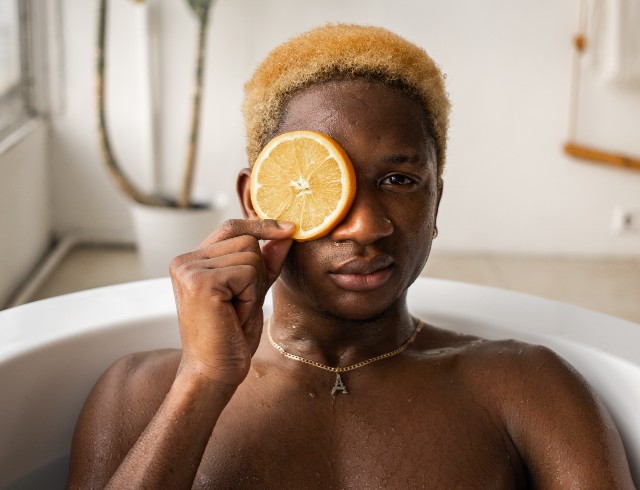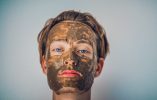How to Get Rid of Pimples Overnight and How To Enjoy Acne-Free Skin Forever

Acne is by no means fatal, but it can be a real bane to a person’s quality of life. It has real effects, whether it’s keeping you from going out with your friends or preventing you from being your bright, happy, boisterous self. Let’s take a closer look at acne, what causes it, and some ways you can reduce, treat, and control breakouts.
What is Acne?
Acne, short for acne vulgaris, is a long-term skin condition that is characterized by inflamed bumps that can . But let’s take a step back here. Your skin is covered in tiny holes called pores. Each of these pores is home to a hair follicle that also connects to an oil gland called the sebaceous gland.
Sebaceous glands are found basically all over your body aside from your palms and the bottoms of your feet. These glands produce an oily liquid called sebum, which travels up the follicle, out the pore, and onto the surface of your skin. That probably sounds unpleasant to you, but sebum is actually necessary to your overall health and wellbeing. Sebum keeps too much water from getting into your system while also keeping you from losing too much water. Sebum can also keep your skin from succumbing to certain bacterial and fungal infections.
So sebum is good. Except when it’s not. See, some people create too much sebum, which your pores can’t handle on top of the debris of dead skin cells, bacteria, and white blood cells. That eventually causes the pore to get blocked up, leaving you with one fresh, juicy pimple.
The Types of Acne
All forms of acne start as a microcomedone, a small initial plugged pore. As sebum builds up within the blocked pore, the microcomedone matures to a full comedone, or pimple. Comedones generally come in three forms that depend on where the blockage started.
Whiteheads
Whiteheads are the classic zit, characterized by a small, round bump filled with a whitish-yellow, pus-like substance. Whiteheads are also known as “closed comedones” and form when the blockage is deeper under the skin.
Blackheads
Blackheads, or open comedones, form from blockages closer to the skin’s surface. Contrary to popular belief, the dark coloration of blackheads has nothing to do with dirt. Sebum contains melanin, the pigment chemical responsible for the color of your hair, eyes, and skin. When melanin hits exposed air, a chemical reaction causes it to turn black.
Cystic acne
Sometimes, the blockage becomes so severe that the pressure breaks down the follicle walls, leading to an even deeper infection. The result is larger bump known as a cyst. Cystic acne is filled with more pus under the surface and can potentially burst, spreading the infection and leading to a full-blown breakout.

What Causes Acne?
The main cause of acne is overproduction of sebum, but what causes your sebaceous glands to get so out of control?
Hormones
A type of hormone known as androgen is known to increase production of sebum. Coincidentally, you tend to create more androgens during puberty, hence why you tend to see more acne when you’re going through those oh-so-great growing pains. Women experiencing hormonal changes, like during pregnancy or menstrual cycles, may also experience more acne as a result.
Genetics
While there isn’t a “acne gene,” your genetics does contribute to various skin factors, like dryness, how well you can shed dead skin, and overproduction of sebum. More than likely, if your parents had a lot of acne as kids, you can expect to deal with plenty of pimples yourself. Thanks, Mom and Dad!
Bacteria
A certain bacteria called Cutibacterium acnes (formerly Propionibacterium acnes) lives on your skin naturally. While it’s neither good nor bad, C. acnes feeds on sebum and cellular debris. When you overproduce sebum, you are essentially providing this bacteria with a delicious buffet that also allows C. acnes to reproduce at an exponential rate. As the C. acnes feeds, it secretes various chemicals that irritate your skin and surrounding tissues. Irritation leads to inflammation, which equates to more blocked pores and more zits.
Stress
The actual science behind this is still under review, but studies have found that stress chemicals can cause the increased production of sebum. Stress also has a direct effect on your immune system, which can keep your body from properly dealing with inflammation or the population of C. acnes populating your skin’s surface.
Really, there is no singular factor that will cause acne or the overproduction of sebum. What causes acne for you may not necessarily be the same for others.
Diet and Acne
While there was initially an understanding that food didn’t have a direct effect on acne, recent studies suggest that your diet can have an effect on your acne. Contrary to what you might think though, chocolate and greasy foods are not the primary culprits. Certain foods have been found to increase sebum production, cause hormone imbalances, and promote inflammation. These foods include:
- Sweets
- High-glycemic foods
- Milk and dairy products
- Alcohol
- Saturated fats
With that in mind, you can potentially keep acne and breakouts at bay by eating a diet full of:
- Low-glycemic foods – High glycemic foods can cause spikes in your blood sugar, which forces increased production of insulin, which can increase inflammation.
- Probiotics – These beneficial bacteria can help your digestive system and support healthy inflammatory response. Probiotic-rich foods include yogurt, kimchi, sauerkraut, and kombucha.
- Omega-3 oils – Omega-3 fatty acids are immensely beneficial to your skin. These mainly come from fatty fish but can also be found in flaxseeds and soy beans.
- Antioxidants – Antioxidants battle free radicals, molecules that cause inflammation and damage cells.
- Selenium – Found in meats, seafood, and certain nuts, selenium is a component of antioxidant enzymes and can help your body’s inflammatory response.
- Zinc – Zinc supports your immune system and can be found in oysters, peanuts, peas, and beans.
Overall, you want to eat a healthy, balanced diet that focuses on a diverse range of fruits, vegetables, unprocessed whole grains, and lean meats. Supplements can also help you get the right amount of nutrients you need. DrFormulas™ Dermatrope, for instance, offers a combination of several nutrients that can help to control acne and promote clear skin.
Acne and pH Balance
Let’s get a little nerdy here. The pH scale measures how acidic or basic (alkaline) any substance is. A pH of 7 is considered neutral (for example, pure, distilled water should have a pH of about 7). Anything below 7 is considered acidic, while anything above that is considered basic or alkaline.
Your skin has something called an acid mantle, which is a thin, protective layer that sits on top of your skin. It is slightly acidic (a pH of about 5.5) and acts as your body’s first defense against any and all bacteria, including C. acnes. Studies have found that the growth of these bothersome bacteria is based on your skin’s pH. Keeping a pH of 5.5 ensures minimal growth, while more alkaline skin will cause that bacteria to grow at a faster rate, increase sweat production, and keep your skin feeling dry.
Balancing your skin’s pH is the key to a lot of your acne problems. Part of that can be accomplished with a good diet. Part of that has to do with the things you put on your skin. For example, most soaps, particularly bar soaps, tend to be slightly more alkaline, which often leaves your skin feeling sensitive and dry. To balance that out, you can use certain treatments that bring the pH back down to acidic levels. On the other hand, making your skin too acidic can cause irritation and strip your skin of vital oils.
This might not mean much to you. Obviously, you’re not going to be sitting in the bathroom, trying to measure your skin’s acidity levels, but it’s good to know and keep in mind when you begin your regimen.
Your Acne Regimen
The best way to treat and prevent acne is to take care of your skin, and the best way to do that is to develop a solid acne regimen that keeps your skin clean, treated, and moisturized, all while balancing your skin’s pH. Your face rituals don’t have to be complex or multi-layered, either. It can be as simple as three steps performed twice a day (once in the morning and once at night).
1. Clean
Cleaning your face is more about getting rid of dirt and excess oil and preparing your skin for the treatment stage than for actually getting rid of acne on its own. Start by choosing a face wash that is mild, gentle, and scent-free. There are a variety of different facial soaps you can choose from. Cetaphil’s Gentle Skin Cleanser is about as basic and mild as it gets.
When cleaning your face, keep gentleness in mind. Don’t rub or scrub hard, which will only irritate any existing acne, strip away essential oils, and probably hurt your skin. As a general rule, you shouldn’t be cleaning for longer than 20 seconds. Ten seconds is even better. Wet your face with warm water, massage the cleanser onto your skin, and rinse away with warm water. Pat dry your face with a clean, lint-free towel.
2. Treat Your Pimples Overnight
You can find a wide range of treatments out there, and each one is effective in its own way. All of them if applied fast enough, can heal your pimples overnight! The three main treatment ingredients you’ll find are:
- Benzoyl peroxide – Benzoyl peroxide is probably the best known of the acne treatments. It is an antibacterial that can get into your pores and specifically target acnes. However, it is strong stuff that can be harsh on particularly sensitive skin. It can also bleach clothing, pillowcases, towels, and other fabrics. Benzoyl peroxide can be found in varying concentrations, but always stick with the lowest 2.5 percent. Higher concentrations have not been found to be any more effective and will likely cause increased irritation an dry, flaky skin that will only create more zits.
- Salicylic acid – Salicylic acid is a BHA (beta-hydroxyl acid) that helps you better shed dead skin cells, preventing pore blockage. Salicylic acid also acts as an anti-inflammatory. It can be much gentler than benzoyl peroxide, though potentially not as effective, particularly on whiteheads.
- Retinol – Retinol, a form of retinoid, can help to unclog pores, promote the shedding of dead skin cells, and reduce acne scars. However, retinol can be rough on sensitive skin, potentially more so than benzoyl peroxide.
You may have to go through some trial and error here, but make sure to only stick with one treatment. Mixing too many treatments can be a lot for your skin, especially when you’re just starting out. When you do choose a treatment, for the first two weeks, apply a thin layer only during your night regimen. This allows your face to get used to the treatment. Too much all at once can cause breakouts.
The nearest pharmacies are closed and you are running out of the above-mentionned cures? Maybe the overnight treatment is closer than you think! Check your kitchen for one of the following acne skin overnight home remedies!
3. Moisturize
As much as dryness might seem beneficial when it comes to overproducing sebum, it’s actually pretty bad. In the short-term, dry skin will force your body to create even more sebum to overcompensate, resulting in even more zits. In the long-term, dry skin will cause wrinkles and an aged look to your skin.
Once you have let your treatment sink in, it’s time to bring some moisture back to your face with a face lotion. There are more face lotions than anything else out there, but look for a light, scentless lotion. The main word you want to look for on the label is “non-comedogenic,” which is a fancy way of saying it won’t clog pores or cause acne. Bonus points if the lotion contains any amount of SPF. Apply enough lotion that your face feels well-covered without also feeling greasy.
And that’s it! As you develop your regimen, you will probably make adjustments, but those three steps should always be the base. Some things you should absolutely add to your regimen:
- Sunblock – Basically all acne treatments make your skin more sensitive to UV rays, which can lead to more pimples, but also increases your risk of skin cancer. If you plan to be out and about in any capacity, for any amount of time, apply a light, non-comedogenic sunblock to your face and reapply when necessary.
- Exfoliator – The right exfoliators will help your skin further shed dead skin cells, tone your face, and generally allow for a more even complexion. Look for other beta-hydroxyl acid and alpha hydroxyl acid (AHA) chemical exfoliators, like lactic acid and salicylic acid. And for the love of all that is holy, avoid Ives Apricot Scrub and other “microbead” exfoliators. Those microbeads are more likely to cause irritation and create micro-tears in your skin (as a general rule, you don’t want to use anything on your skin that will cause any type of tearing) that increase chances of scarring and infection and causes long-term damage to your skin. Those microbeads are also not good for the environment. St. Ives Apricot Scrub and its similar ilk are best reserved for scrubbing callouses off the bottoms of your feet. You deserve better. Stick with AHA and BHA exfoliants and peels.
- Face masks – Face masks have a variety of different purposes, from adding moisture to providing extra ingredients that your skin might crave. More than anything, face masks are just an easy, affordable way to treat yourself to a little bit of luxury. They are relaxing and comforting, which in its own way is a good way to treat your skin and yourself.
Acne and Your Lifestyle
Along with your diet and your regimen, you can do little things in your life to prevent or treat acne.
- Don’t touch your face. Touching or rubbing your face or picking at zits only introduces more foreign bacteria, which increases the likelihood of acne and breakouts.
- Don’t pop your zits. There’s a right way to squeeze your zits if they look ripe for the popping, but more often than not, you’re better off leaving that zit alone and allowing it to go through its own lifecycle. Popping incorrectly will only spread more bacteria (which conveniently leads to more breakouts) and create scars. Absolutely do not pop cystic acne.
- Change out your pillowcase regularly. Think about all the oil, sweat, and drool that accumulates on your pillowcase. Then think about how much time your face actually spends on your pillowcase. Alternately, you can switch out clean towels onto your pillow every night.
- Drink plenty of water. Water keeps you hydrated from the inside out and helps your body shed dead skin cells more efficiently. It’s also just a good idea for your overall health. The general rule is 8 cups of water a day, but you can generally get by if you drink one cup of water with every meal and then water whenever you are thirsty throughout the day.
Acne doesn’t have a cure. Some people are just blessed with clear, dewy, poreless skin. If you’re lucky, you’ll age out of it, but adult acne is absolutely a thing that many people have to deal with. While it’s okay to be bothered by acne, do your best to keep it off your mind. Often the best way to treat acne (on top of all of the above) is to not let it ruin your day.




